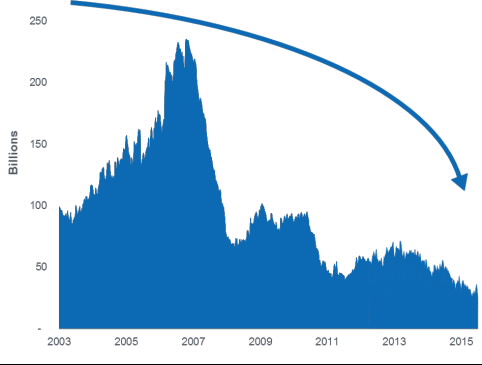The corporate bond situation has also been made precarious due to the amount of issuance brought on by the low interest rates primarily caused by the Fed’s purchases. With the Fed’s demand for bonds being added to the normal demand, yields fell to historic lows. This in turn allowed companies to issue bonds with very advantageous interest rates. Even companies with lower credit or re-paying capability have issued large amounts of debt at unnaturally low interest rates. As the chart below illustrates, a large gap or bubble has formed in the amount of debt issued by these company’s whose ability to re- pay may become stressed in more difficult economic times. As credit risks escalate, the yields on these bonds should rise to compensate for the extra risk. It hasn’t happened yet, but the gap is clear.
Another factor to know about is that the liquidity provided by the primary bond dealers today is much less than just a few years ago. As the chart below shows, primary dealer inventory is less than one quarter what it was at the beginning of the financial crisis. If the corporate bond desks have smaller inventories and are less likely to buy or trade, this means liquidity will dry up faster and yields are likely to rise, causing prices to fall, when we have our next economic recession.
So why does this matter?
We are not trying to predict the future but rather to stimulate thought around risk control in the bond markets. Much has changed at the macro level and it is always best that we all understand the risks and educate clients to the macro risks present in today’s bond markets. Disaster is far from certain, but caution and proper portfolio positioning in both equity and fixed income may be warranted sooner rather than later.
The views and opinions expressed throughout this paper are those of our Portfolio Manager as of March 9, 2017. The opinions and outlooks may change over time with changing market conditions or other relevant variables.The information presented in this paper is based on data obtained from third party sources. Although it is believed to be accurate, no representation or warranty is made as to its accuracy or completeness.
Past performance is no guarantee of future results. Diversification does not ensure a profit or guarantee against a loss. As with all investments, there are associated inherent risks. An investment cannot be made directly in an index. Beaumont Financial Partners, LLC DBA Beaumont Capital Management – 250 1st Avenue, Suite 101, Needham, MA 02494 – (844) 401 -7699 [email protected]:
1. The Balance: U.S. GDP by Year Compared to Recessions and Major Events. The Strange Ups and Downs of the U.S. Economy Since 1929. Kimberly Amadeo, March 1, 2017.
2. CNSnews.com: U.S. Has Record 10th Straight Year Without 3% Growth in GDP. Terence P. Jeffrey, February 26, 2016.


